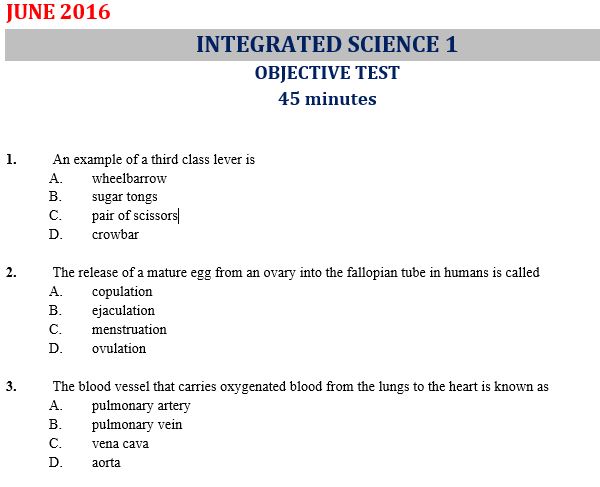
BECE Integrated Science 2016 Past Questions & Answers – Papers 2 & 1
JUNE 2016
INTEGRATED SCIENCE 2
ESSAY
1 ¼ hours
This paper is in two parts: I and II. Answer Question 1 in part I and any other four questions in part II
PART I
[40 marks]
Answer all of Question 1
1. (a) The funnels in the diagram below contain equal amounts of different types of soils labelled K, L and M. Equal volumes of water were poured onto each soil at the same time and allowed to drain for 20 minutes.
Study the diagram and answer the questions that follow
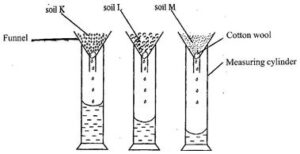
(i) What is the aim of the experiment? [2 marks]
(ii) Which soil has the highest rate of drainage? [1 mark]
(iii) Which soil has the highest water retention capacity? [1 mark]
(iv) Which soil is most likely to lose water and dry faster after rainfall? [1 mark]
(v) Which soil is most likely to be waterlogged after rainfall? [1 mark]
(vi) Which of the soil types would be suitable for maize cultivation? [1 mark]
(b) The diagram below illustrates hazard symbols labelled I, II, III and IV.
Study the diagram carefully and answer the questions that follow.
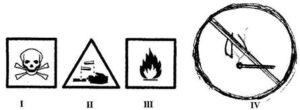
(i) What does each of the symbols labelled I, II, III and IV represent?
(ii) Name one substance each that is associated with:
(α) I;
(β) II;
(γ) III. [3 marks]
(iii) Name a place where the hazard symbol labelled IV is often displayed [1 mark]
(iv) Which of the symbol(s) is / are found on chemical containers? [3 marks]
(c) The diagrams below are illustrations of devices used to do work easily
Study the diagrams and answer the questions that follow
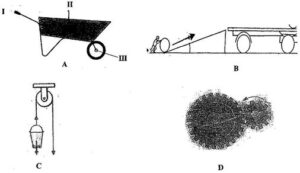
(i) Give a general name for the devices. [1 mark]
(ii) Identify each of the devices labelled A, B, C and D. [4 marks]
(iii) Name the parts labelled I, II and III of device A when it is considered as a lever.
[3 marks]
(iv) What does the arrow represent in the device labelled B? [1 mark]
(v) Name the type of work done with each of the devices labelled:
(α) C;
(β) D; [2 marks]
(d) The diagram below illustrates the digestive system in humans.
Study the diagram carefully and answer the questions that follow
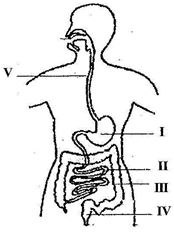
(i) Name each of the parts labelled I, II, III, IV and V [5 marks]
(ii) Name the part(s) of the digestive system where
(α) digestion of food substances occur
(β) digested food is absorbed into the bloodstream [3 marks]
(iii) Name the end-products of the digestion that is absorbed into the bloodstream
[3 marks]
PART II
[60 marks]
Answer four questions only from this section
2. (a) Name four weather measuring instruments. [4 marks]
(b) Name the stages in the life cycle of a mosquito. [4 marks]
(c) (i) List two properties of water
(ii) Explain why it is advisable to wash clothes with soft water [4 marks]
(d) State three ways in which soil profile is important. [3 marks]
3. (a) List three modes of heat transfer. [3 marks]
(b) (i) What is a deficiency disease?
(ii) Name three deficiency diseases in humans. [5 marks]
(c) State two ways in which each of the following factors cause depletion of soil resources:
(i) burning
(ii) leaching [4 marks]
(d) List three processes that can change matter from one state to another. [3 marks]
4. (a) (i) What is a satellite?
(ii) Give three uses of artificial satellites. [5 marks]
(b) State the composition of each of the following alloys:
(i) brass
(ii) steel
(iv) bronze [3 marks]
(c) Name three cultural practices used in vegetable production. [3 marks]
(d) List four parts of the respiratory system in humans. [4 marks]
5. (a) (i) What is a force?
(ii) State two ways in which forces could affect a body [4 marks]
(b) (i) What is a chemical change?
(ii) State three differences between chemical change and physical change.
[5 marks]
(c) Name three physical properties of soil. [3 marks]
(d) Mention three diseases of the circulatory system in humans. [3 marks]
6. (a) Write the systematic name for each of the following compounds:
(i) H2O
(ii) MgO
(iii) CaO
(iv) CaCl2 [4 marks]
(b) Name the instrument used in measuring the following:
(i) length of a rope
(ii) mass of a stone
(iii) temperature of a liquid
(iv) volume of a liquid [4 marks]
(c) List three factors that influence vegetable crop production. [3 marks]
(d) Name four stages in the life cycle of a flowering plant. [4 marks]
END OF PAPER 2 (ESSAY)
JUNE 2016
INTEGRATED SCIENCE 2
ESSAY
ANSWERS
1. (a) (i) The aim of the experiment [2 marks] To determine the drainage ability / water-holding capacity of the soils
(ii) Soil with the highest rate of drainage [1 mark] Soil K
(iii) Soil with the highest water retention capacity [1 mark] Soil M
(iv) The soil most likely to lose water and dry faster after rainfall [1 mark] Soil K
(v) The soil most likely to be waterlogged after rainfall [1 mark] Soil M
(vi) Which of the soil types would be suitable for maize cultivation? [1 mark] Soil L
(b) (i) What each of the symbols labelled I, II, III and IV represent
I – Danger
II – Corrosive
III – Highly inflammable / highly flammable
IV – No naked flame
(ii) One substance each that is associated with:
(α) I; DDT, Hydrogen cyanide, Salicylic acid
(β) II; Concentrated Inorganic acids, such as HCl, H2SO4, HNO3,
Concentrated inorganic bases, such as NaOH, KOH, Ca(OH)2
Household bleach
(γ) III. Petrol, Kerosene, LPG, Perfume, Insecticides, Alcohol [3 marks]
(iii) A place where the hazard symbol labelled IV is often displayed [1 mark] Gas Filling stations, Storage places of combustible substances
(iv) Symbol(s) found on chemical containers [3 marks] I, II and III
(c) (i) General name for the devices. [1 mark] Simple machines
(ii) Identification of each of the devices labelled A, B, C and D. [4 marks]
A – Wheel barrow
B – Inclined plane
C – Pulley
D – Gear
(iii) The parts labelled I, II and III of device A when it is considered as a lever.
[3 marks]
I – Effort
II – Load
III – Pivot
(iv) What the arrow represents in the device labelled B [1 mark] Direction of effort / effort distance
(v) The type of work done with each of the devices labelled:
(α) C; Lifting objects
(β) D; moving a vehicle or parts of an engine efficiently
[2 marks]
(d) (i) Names of the parts labelled I, II, III, IV and V [5 marks] I – Stomach
II – Small intestines
III – Large intestines
IV – Rectum
V – Oesophagus / gullet
(ii) The part(s) of the digestive system where
(α) digestion of food substances occur
I and II
(β) digested food is absorbed into the bloodstream [3 marks] II
(iii) The end-products of the digestion that is absorbed into the bloodstream
[3 marks]
Amino acids, glucose, fatty acids and glycerol
2. (a) Four weather measuring instruments. [4 marks] Barometer, rain gauge, anemometer, wind vane, hygrometer, sun dial / lightmeter
(b) The stages in the life cycle of a mosquito. [4 marks] Egg stage, larva stage, pupa stage and adult stage
(c) (i) Two properties of water
• Colourless
• Odourless
• Tasteless
• Boils at 100°C
• Freezes at 0°C
(ii) Why it is advisable to wash clothes with soft water [4 marks]
- It lathers better with soap, since it does not contain dissolved salts such as calcium carbonate, magnesium hydroxide and calcium sulphate.
- There is no production of scum, therefore it makes washing easier and faster.
(d) Three ways in which soil profile is important. [3 marks]
• to determine the type of crop to grow
• to determine the most suitable farming system to use
• to determine the type / amount of fertilizer needed
• to determine the cultural practices to use
• to determine the type of tools / equipment to use
• to determine the cost of production
3. (a) Three modes of heat transfer. [3 marks] Conduction, convection and radiation
(b) (i) What a deficiency disease is
A disease that results from the lack or shortage of certain nutrients in the body of an organism
(ii) Three deficiency diseases in humans. [5 marks] Kwashiorkor, goiter, rickets, anaemia, scurvy, night blindness
(c) Two ways in which each of the following factors cause depletion of soil resources:
(i) burning
kills soil micro organism, such as nitrogen-fixing bacteria
makes the land bare, which results in soil erosion
causes faster evaporation of soil water
destroys soil nutrients
(ii) leaching [4 marks]
washes away water-soluble plant nutrients, especially nitrates and sulphur.
leads to soil acidity
affects the texture of the topsoil.
(d) Three processes that can change matter from one state to another. [3 marks]
Freezing
Condensation
Sublimation
Melting
Evaporation
Deposition
4. (a) (i) What a satellite is.
A body that moves around / orbits a planet.
(ii) Three uses of artificial satellites. [5 marks]
weather forecasting
communication
scientific exploration
Navigation – using GPS, etc.
television/ radio broadcast
military purposes
(b) The composition of each of the following alloys:
(i) brass
copper and zinc
(ii) steel
iron and carbon
(iii) bronze [3 marks] copper and tin
(c) Three cultural practices used in vegetable production. [3 marks]
Weeding
Pruning
Mulching
Watering
Thinning out
Staking
(d) Four parts of the respiratory system in humans. [4 marks] Nostril, bronchus, bronchioles, alveoli, trachea, pharynx, blood capillaries
5. (a) (i) What a force is
A push or pull on an object.
(ii) Two ways in which forces could affect a body [4 marks]
A force can:
cause a stationery body to move
cause a moving body to stop
increase the speed of a moving body (acceleration)
decrease the speed of a moving body (deceleration)
change the shape of a body
(b) (i) What a chemical change is
A change in which a new substance is formed and is irreversible, eg, the neutralization reaction between HCl and NaOH
(ii) Three differences between chemical change and physical change.
| CHEMICAL CHANGE | PHYSICAL CHANGE |
| A new substance is formed | No new substance is formed |
| It is irreversible (not reversible) | It is usually reversible |
| Heat energy is given off or absorbed | No heat energy given off or absorbed |
| Chemical bonds are broken and new ones form | Chemical bonds are not broken and no new ones are formed |
(c) Three physical properties of soil. [3 marks]
Soil Texture,
Soil Structure,
Water-holding capacity/ permeability / porosity
Soil colour
Bulk density
Soil temperature
Soil Consistency / Soil strength
(d) Three diseases of the circulatory system in humans. [3 marks]
Anaemia
Haemophilia
Coronary artery disease
Arteriosclerosis
Leukemia
stroke
hypertension
heart failure
heart attack
Aortic dissection
Cardiomyopathy, etc
6. (a) The systematic name for each of the following compounds:
(i) H2O – Dihydrogen monoxide or hydrogen oxide
(ii) MgO – Magnesium oxide
(iii) CaO – Calcium oxide
(iv) CaCl2 – Calcium chloride [4 marks]
(b) The instrument used in measuring the following:
(i) length of a rope –
Metre rule or tape measure
(ii) mass of a stone –
Beam balance, triple beam balance,
(iii) temperature of a liquid-
Mercury-in-glass thermometer, alcohol thermometer
(iv) volume of a liquid –
Measuring/graduated cylinder, beaker, pipette, volumetric flask, measuring cup/jug
[4 marks]
(c) Three factors that influence vegetable crop production. [3 marks]
Site selection
Quality of crop variety /planting material
Nature of soil
Climate / weather conditions
Cultural practices
Harvesting
Storage
Marketing
(d) Four stages in the life cycle of a flowering plant. [4 marks]
Germination
Seedling
Mature plant
Flowering
Pollination
Fertilization
Formation of seeds and fruits
Dispersal of seeds and fruits
END OF PAPER 2 (ESSAY) ANSWERS
JUNE 2016
INTEGRATED SCIENCE 1
OBJECTIVE TEST
45 minutes
1. An example of a third class lever is
A. wheelbarrow
B. sugar tongs
C. pair of scissors
D. crowbar
2. The release of a mature egg from an ovary into the fallopian tube in humans is called
A. copulation
B. ejaculation
C. menstruation
D. ovulation
3. The blood vessel that carries oxygenated blood from the lungs to the heart is known as
A. pulmonary artery
B. pulmonary vein
C. vena cava
D. aorta
4. An example of a plant micro-nutrient is
A. calcium
B. copper
C. magnesium
D. potassium
5. What is the colour of the neutral wire in a three-pin plug?
A. Blue
B. Brown
C. Green
D. Yellow
6. In the pin-hole camera, the image formed is always
A. erect and bright
B. erect and blurred
C. inverted and real
D. inverted and virtual
7. The part of the flower that develops into a fruit is the
A. ovary
B. ovule
C. stamen
D. style
8. The number of elements in the compound Ca(OH)2 is
A. 2
B. 3
C. 4
D. 5
9. The reason why alum is added to water during treatment is to
A. kill germs
B. give taste to water
C. make water colourless
D. make suspended particles settle
10. Which of the following animal parasites could be controlled by hand picking?
A. Liver fluke
B. Tapeworm
C. Tick
D. Roundworm
11. A stick which is partially immersed in water appeared to be bent due to
A. absorption
B. reflection
C. refraction
D. transmission
12. One difference between metals and non-metals is that metals
A. have low density
B. are not malleable
C. have luster
D. have low melting points.
13. The cultivation of different crops on different plots of a farmland in a definite cycle is called
A. land rotation
B. shifting cultivation
C. crop rotation
D. mixed cropping
14. Iodine deficiency in humans could result in a disorder known as
A. diabetes
B. goiter
C. kwashiorkor
D. scurvy
15. A substance is termed combustible if it
A. easily catches fire
B. dissolves common salt
C. sublimes at room temperature
D. boils at 100°C.
16. Micro-organisms that cause diseases are collectively called
A. bacteria
B. infections
C. pathogens
D. viruses
17. Which type of energy is lost when sweat evaporates from the human body?
A. Sound energy
B. Mechanical energy
C. Chemical energy
D. Heat energy
18. Which of the following gases is involved in the rusting of iron?
A. Hydrogen
B. Oxygen
C. Nitrogen
D. Carbon dioxide
19. The feeling of soil between fingers is used to determine the
A. texture of the soil
B. drainage of the soil
C. capillarity of the soil
D. water holding capacity of the soil.
20. Sodium hydroxide is an example of a base because it
A. has sour taste
B. has a pH less than 7
C. turns wet blue litmus paper red
D. turns wet red litmus paper blue
21. Which of the following plants has its leaves modified for storing food?
A. Ginger
B. Onion
C. Pineapple
D. Tomato
22. Gases enter and leave the leaf of a plant through the
A. mesophyll cells
B. stomata
C. pith
D. palisade cells
23. Which of the following vegetable crops is cultivated for its leaves?
A. Carrrot
B. Lettuce
C. Okro
D. Pepper
24. An example of a body that does not produce its own light is the
A. moon
B. sun
C. star
D. fire fly
25. Which of the following devices converts electrical energy into sound energy?
A. Electric heater
B. Electric fan
C. Washing machine
D. Loudspeaker
26. Transplanting of young seedlings is usually done in the evening because
A. darkness promotes rapid growth
B. seedlings require less nutrients
C. pest attack is minimal
D. transpiration is minimal
27. A mixture of sugar and water could be separated by
A. decantation
B. evaporation
C. filtration
D. sublimation
28. Which of the following processes results in the formation of new substances?
A. Cooling water to form ice
B. Adding saliva to cooked yam
C. Dissolving sugar in water
D. Mixing iron dust and sand
29. Photosynthesis is important to living organisms because it produces
A. glucose and oxygen
B. glucose and carbon dioxide
C. oxygen and carbon dioxide
D. water and carbon dioxide
30. Global warming is caused by the
A. circulation of oxygen in the atmosphere
B. excessive release of carbon dioxide into the atmosphere
C. release of hydrogen into the atmosphere
D. circulation of nitrogen in the atmosphere
31. The warning and safety signs on chemical containers are usually represented by a symbol placed within a
A. circle
B. rectangle
C. square
D. triangle
32. In which of the following structures in a living cell is cellulose found?
A. Chloroplast
B. Mitochondrion
C. Cell membrane
D. Cell wall
33. Elements that could easily lose electrons to form cations are
A. metals
B. non-metals
C. semi-metals
D. noble gases
34. The conversion of agricultural produce from its original form to other desirable forms is termed
A. preservation
B. processing
C. recycling
D. storage
35. The function of the hair in the nose of humans is to
A. make breathing easier
B. keep nose moist
C. filter dust from the air breathed in
D. keep the nose warm
36. A metal that is used as a thermometric liquid is
A. aluminium
B. copper
C. mercury
D. silver
37. The joule is the S.I unit for
A. energy
B. force
C. power
D. pressure
38. Which of the following gases supports combustion?
A. Hydrogen
B. Oxygen
C. Carbon dioxide
D. Carbon monoxide
39. The form of energy which flows from one point to another due to temperature differences is known as
A. mechanical energy
B. heat energy
C. solar energy
D. nuclear energy
40. Which of the following resources does not produce energy?
A. Coal
B. Sand
C. Water
D. Wind
END OF PAPER 1 (OBJECTIVES)
JUNE 2016
INTEGRATED SCIENCE 1
OBJECTIVE TEST
ANSWERS
1. B. sugar tongs
2. D. ovulation
3. B. pulmonary vein
4. B. copper
5. A. Blue
6. C. inverted and real
7. A. ovary
8. B. 3
9. D. make suspended particles settle
10. C. Tick
11. C. refraction
12. C. have luster
13. C. crop rotation
14. B. goiter
15. A. easily catches fire
16. C. pathogens
17. D. Heat energy
18. B. Oxygen
19. A. texture of the soil
20. D. turns wet red litmus paper blue
21. B. Onion
22. B. stomata
23. B. Lettuce
24. A. moon
25. D. Loudspeaker
26. D. transpiration is minimal
27. B. evaporation
28. B. Adding saliva to cooked yam
29. A. glucose and oxygen
30. B. excessive release of carbon dioxide into the atmosphere
31. D. triangle
32. D. Cell wall
33. A. metals
34. B. processing
35. C. filter dust from the air breathed in
36. C. mercury
37. A. energy
38. B. Oxygen
39. B. heat energy
40. B. Sand
END OF PAPER 1 (OBJECTIVES) ANSWERS
Click on the sharing buttons below ↓ to share with your friends
Yes